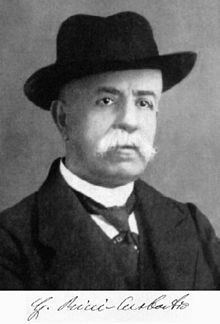Nationality Italian | Name Gregorio Ricci-Curbastro Role Mathematician | |
 | ||
Born 12 January 1853Lugo di Romagna ( 1853-01-12 ) Known for Tensor calculusRicci calculus Similar People Tullio Levi‑Civita, Enrico Betti, Ulisse Dini | ||
GREGORIO RICCI CURBASTRO
Gregorio Ricci-Curbastro ([ɡreˈɡɔːrjo ˈrittʃi kurˈbastro]; 12 January 1853 – 6 August 1925) was an Italian mathematician born in Lugo di Romagna. He is most famous as the inventor of tensor calculus, but also published important works in other fields.
Contents
- GREGORIO RICCI CURBASTRO
- Il Rotary per Gregorio Ricci Curbastro
- Youth
- Studies on absolute differential calculus
- Influences
- Recognition
- Publications
- References
With his former student Tullio Levi-Civita, he wrote his most famous single publication, a pioneering work on the calculus of tensors, signing it as Gregorio Ricci. This appears to be the only time that Ricci-Curbastro used the shortened form of his name in a publication, and continues to cause confusion.
Ricci-Curbastro also published important works in other fields, including a book on higher algebra and infinitesimal analysis, and papers on the theory of real numbers, an area in which he extended the research begun by Richard Dedekind.
Il Rotary per Gregorio Ricci Curbastro
Youth
Born in lower Romagna. His family was amongst the most ancient and noble of the families of Lugo, and by tradition deeply Catholic.
When Pope Pius IX made his only journey to Romagna (1857), he stayed at Lugo at the family palace. This intense religious faith was an element which strongly characterized the whole life of Gregorio. Completing privately his high school studies at only sixteen years of age he enrolled on the course of philosophy-mathematics at Rome University (1869). The following year the Papal State fell and so Gregorio was called by his father to the city of his birth, Lugo. Subsequently he attended courses at Bologna, but after only one year he enrolled at the Scuola Normale Superiore di Pisa.
In 1875, he graduated in Pisa in Physical Sciences and mathematics with a thesis on differential equations, entitled “On Fuches’s Research Concerning Linear Differential Equations”. During his various travels he was a student of mathematicians of the calibre of Enrico Betti, Eugenio Beltrami, Ulisse Dini and Felix Klein.
Studies on absolute differential calculus
In 1877 Ricci-Curbastro obtained a scholarship at the Technische Hochschule of Munich, Bavaria, and he later worked as an assistant of Ulisse Dini, his teacher.
In 1880 he became a lecturer of mathematics at the University of Padua where he dealt with Riemannian geometry and differential quadratic forms.
He formed a research group in which Tullio Levi-Civita worked, with whom he wrote the fundamental treatise on absolute differential calculus (also known as Ricci calculus) with coordinates or tensor calculus on Riemannian manifold, which then became the lingua franca of the subsequent theory of Einstein's general relativity. In fact absolute differential calculus had a crucial role in developing the theory, as is shown in a letter written by Albert Einstein to Ricci-Curbastro's nephew. In this context Ricci-Curbastro identified the so-called Ricci tensor which would have a crucial role within that theory.
Influences
The advent of tensor calculus in dynamics goes back to Lagrange, who originated the general treatment of a dynamical system, and to Riemann, who was the first to think about geometry in an arbitrary number of dimensions. He was also influenced by the works of Christoffel and of Lipschitz on the quadratic forms. In fact, it was essentially Christoffel’s idea of covariant differentiation that allowed Ricci-Curbastro to make the greatest progress.
Recognition
Ricci Curbastro received many honours for his contributions.
He is honoured by mentions in various Academies amongst which are:
He participated actively in political life, both in his native town and in Padua, and contributed with his projects to the Ravenna-area land drainage and the Lugo aqueduct.
An asteroid, 13642 Ricci, is named after him.
